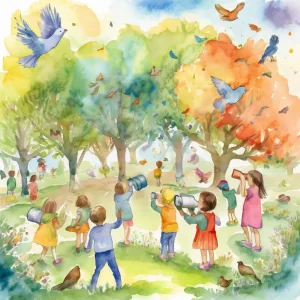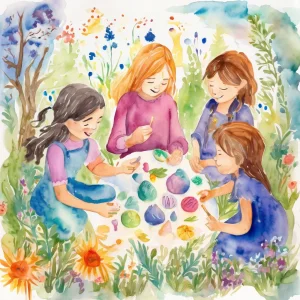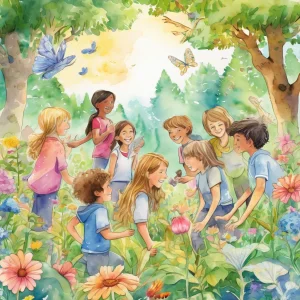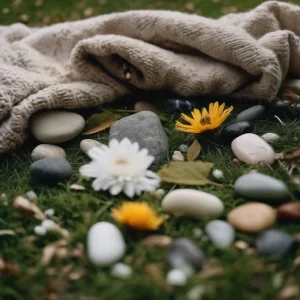Activity
Similar Activities
Nature Shapes Adventure: Bird Watch & Scavenger Hunt
Children’s Age: 4–5 years
Activity Duration: 10 minutes
An outdoor activity for children aged 4-5 years combining bird watching and shape recognition.
Activity Duration: 10 minutes
Whispers of Nature Rhythms: Exploring Beats and Patterns
Children’s Age: 3–7 years
Activity Duration: 10 – 30 minutes
Let's explore "Nature Rhythms" together! We will listen to nature's beats and patterns using rocks, sticks, leaves, and pinecones. Find a safe outdoor spot, gather natural material…
Activity Duration: 10 – 30 minutes
Enchanted Nature-Based Storytelling Adventure
Children’s Age: 0 month – 6 years
Activity Duration: 5 – 10 minutes
Let's have fun with Nature-Based Storytelling! Find a cozy outdoor spot, lay down a blanket, and bring a basket for collecting leaves and stones. Sit with your child, explore natur…
Activity Duration: 5 – 10 minutes
Enchanted Sensory Nature Walk for Babies (0-6 months)
Children’s Age: 0 – 6 months
Activity Duration: 5 – 10 minutes
Explore the Sensory Nature Walk for Babies (0-6 months) to introduce your little one to the wonders of the natural world. This activity supports cognitive, social-emotional, and ad…
Activity Duration: 5 – 10 minutes
Whispers of Nature: Nature Collage Creations
Children’s Age: 2–2.5 years
Activity Duration: 15 minutes
Explore the "Nature Collage Creations" activity tailored for 24 to 30-month-old children, fostering motor skills, language development, and empathy through crafting. Gather leaves,…
Activity Duration: 15 minutes
Nature-Inspired Playdough Sculpting: Creative Nature Explorations
Children’s Age: 3–4 years
Activity Duration: 5 – 15 minutes
Children will enjoy a nature-inspired playdough sculpting activity designed to boost creativity, fine motor skills, and communication. Simply gather homemade playdough, nature item…
Activity Duration: 5 – 15 minutes
Enchanted Forest Math Quest: Nature's Math Adventure
Children’s Age: 12–16 years
Activity Duration: 1 hour
Nature's Math Adventure is an engaging activity designed for children aged 12 to 16 years. It promotes cognitive development, ecological awareness, and healthy habits while incorpo…
Activity Duration: 1 hour
Enchanted Forest: Nature Theater Digital Adventure
Children’s Age: 6–10 years
Activity Duration: 30 minutes
The "Nature Theater: Digital Storytelling Adventure" activity blends nature, theater, and technology to nurture children's creativity, cognitive skills, and self-regulation abiliti…
Activity Duration: 30 minutes
Cultural Collage Scavenger Hunt: Global Discovery Journey
Children’s Age: 12–16 years
Activity Duration: 30 – 50 minutes
Engage children in the "Cultural Collage Scavenger Hunt," a fun and educational activity promoting cognitive development and empathy through exploring diverse cultures. Set up work…
Activity Duration: 30 – 50 minutes
Nature's Touch: Sensory Nature Exploration for Babies
Children’s Age: 3 – 9 months
Activity Duration: 5 – 10 minutes
Engage your 3 to 9-month-old baby in a sensory nature exploration activity to support their development. Lay them on a soft blanket with safe natural objects and optional toys. Des…
Activity Duration: 5 – 10 minutes
Wonderful Beginnings: The Sensory Nature Walk
Children’s Age: 0 – 3 months
Activity Duration: 5 – 10 minutes
Experience a calming and stimulating Sensory Nature Walk designed for infants aged 0 to 3 months. Prepare with a soft carrier, cozy blanket, sunscreen, and a nature sounds playlist…
Activity Duration: 5 – 10 minutes
Enchanted Nature Discovery: Sensory Nature Exploration
Children’s Age: 1.5–2 years
Activity Duration: 10 – 15 minutes
Engage your 12 to 18-month-old in the Sensory Nature Exploration activity, fostering their sensory development through natural exploration. Set up a sensory bin with sand or water,…
Activity Duration: 10 – 15 minutes




























